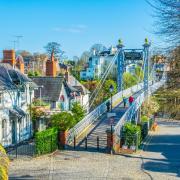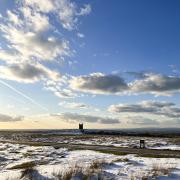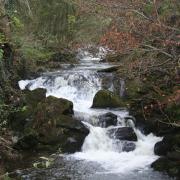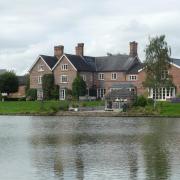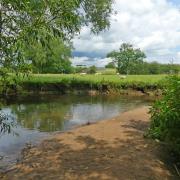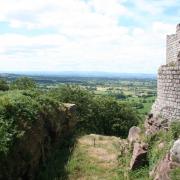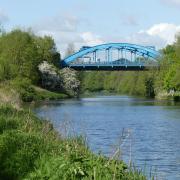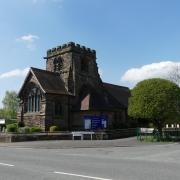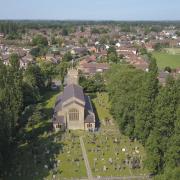To the civil parish of Bunbury this month, for an easy walk through fields around the village

A small and rather lovely village, Bunbury’s name has two distinct claims to fame - one historical and one literary. The Bunbury Agreement of December 23 1642 was an effort by local leading lights from the Royalist and Parliamentarians to keep Cheshire out of the impending English Civil War.
The peace plan forged in the village did not last. National commanders were not minded to allow Cheshire to sit on the sidelines, the Bunbury Agreement collapsed, and on March 13 1643, the First Battle of Middlewich took place.
Bunbury’s literary claim to fame? Anyone who has seen Oscar Wilde’s The Importance of Being Earnest will recall that Bunbury was a fictitious poorly friend, hence ‘Bunburying’ is avoiding an obligation by claiming to be visiting a sick (non-existent) friend.
One good reason to visit Bunbury is St Boniface Church - a Grade I listed building described by Pevsner as ‘one of the largest and most important Cheshire medieval churches’. A place of worship stood on this site in the 8th century, first a wooden Anglo-Saxon church, then a stone Norman church, then, in the 14th century, the church we see today, though added to and restored down the years.

St Boniface also boasts the finest surviving medieval tomb in Cheshire. The alabaster effigy is of Sir Hugh Calveley, born in Lea, Cheshire, around 1320, and one of the most famous soldiers of the Hundred Years War.
Call at the church at the start of this walk, before your boots get muddy. And they will get muddy on this picturesque ramble through flat pastures. But at least in winter the cattle will be indoors, so, for the bovinophobics among you, no cow avoidance strategies will be needed.
1. The walk starts from Vicarage Lane in the village, where you will find limited parking. Head for postcode CW6 9PB. If you plan to eat at the Dysart Arms, you could use the pub car park and begin the walk from there. Assuming you are starting from the village, head along Vicarage Lane, passing the Co-operative shop and the Nag’s Head pub on your right. Take care as you go down Vicarage Lane out of the village centre as there is no pavement. The lane winds up to St Boniface Church. Bear left here, passing the Dysart Arms on your left, and then go right, beside the church yard, along Bowe’s Gate Road, passing a pretty row of houses which includes Widow’s Cottage and Rose Cottage.

2. Beyond the church yard, pass a large green on the right. Just after it, look for a stile on the right. Follow the path across the field towards the trees. Cross a stile beside a gate and go right, through the car park for Bunbury Mill. When you reach the visitors’ centre, go right in front of it, following a path around to the back of the building where boardwalks will bring you to a stile. Cross over it, head up the hill for a few yards, but then bear right towards a large tree on its own. Just before the tree, go left, heading in the direction of six tall trees in the distance, to find a stile just to the right of a field gate. Head slightly right across the next field, aiming to the left of a large yellowy house, and follow the hedge line beside it to find a stile.
3. Head right up the lane and after 200 yards, go left into an unmade lane with a footpath sign. Soon after, it forks. Go right towards a farmhouse, but just a few yards later, go left, following a home-made sign ‘footpath this way’ around the farm. Reaching a stile, go left up the farm track, through a metal gate a few yards later and then head uphill a few yards and then right, following the fence line. Cross another stile and stick to the right hand field edge, and when the fence swings to the right, keep ahead to find a metal gate at about 11 o’clock. Keep to the right edge of the next field, going towards the right side of a large house. Ignore the stile which brings you to this house. Instead, when you are level with the house, bear right along the field edge on a path which leads directly away from the house, passing a dead tree on your right and head down to a stile with a footbridge over a stream.
4. Head across the next large field, aiming between the telegraph poles to find a stile on the very top boundary. Cross the stile and, ignoring a path and stile to the right, keep ahead, along a field edge with a section of wooden fence. Go through a kissing gate ahead and into a more enclosed path. Keep on this path until you come to a wooden kissing gate on the right, with a metal water tank beside it. Head right here, passing through a couple more gates until you emerge onto Hurst Close. Go left here and you will soon reach Vicarage Lane and the heart of the village.

COMPASS POINTS
Area of Walk: Bunbury
Distance: three miles

Time to allow: 1½ hours
Map: OS Explorer 257
Refreshments: The Dysart Arms, Bowe’s Gate Road, Bunbury, Tarporley CW6 9PH; The Nags Head, Vicarage Lane, Bunbury CW6 9PB
Ordnance Survey maps are available from all good booksellers and outdoor stores or visit our online shop www.ordnancesurvey.co.uk/al






